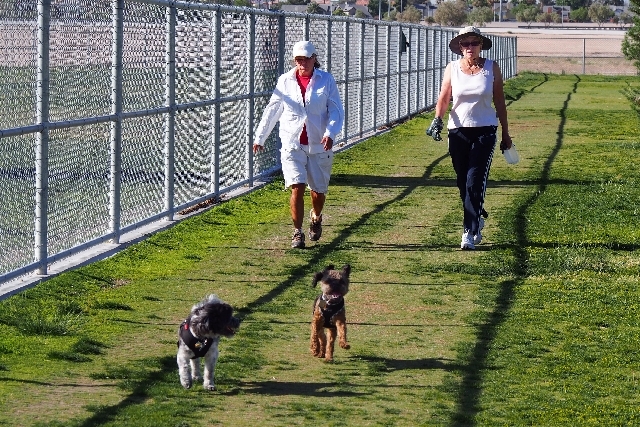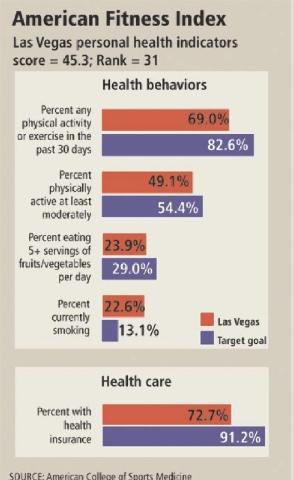Local park space, especially for dogs, high, but activity not ideal
New data reflecting the health of American cities puts Las Vegas only a schnauzer’s whisker away from concluding that residents second the position of Mark Twain: “The more I know about people, the better I like my dog.”
The American College of Sports Fitness Index report released Wednesday shows that Las Vegas has four and a half times the number of dog parks considered necessary by experts. But just when it seems only one thing comes through as loud and clear as a collie in heat howling outside your bedroom window at midnight –– Las Vegas has gone to the dogs –– you learn from the report that although this area has more diabetics than many others, the rate of people dying from the disease is the lowest in the nation.
“I must say those are very odd indicators for a city to lead the country in,” said Shannon Monnat, an assistant professor of sociology at the University of Nevada, Las Vegas.
But, oddly, lead Las Vegas does. And not from the back this time. Yes, Las Vegas may rank 39th in the country out of 50 metropolitan areas when it comes to health behaviors, chronic health problems, recreational facilities and environmental indicators, but in three categories –– dog parks, keeping diabetics alive and money spent on parks –– the valley is considered to have “areas of excellence (at or better than a target goal)” by national fitness experts.
When it comes to park-related expenditures per 100,000 people from 2008 to 2012, the $234 spent in Las Vegas is second only to the $263 in park-related expenditures per capita in San Francisco. The target goal is $101.80.
Overall, the Minnesota metropolitan area of Minneapolis-St. Paul-Bloomington is No. 1 in the country with a score of 78.2. The Washington, D.C., metro area is a close second at 77.7. The Oklahoma City area finishes last at 31.2, just ahead of Detroit at 33.6. In 39th position, Las Vegas has a score of 41.6.
National fitness experts set target goals in each health area to encourage leaders in American cities to make positive changes in their communities, said Sam Nussbaum, chief medical officer for the Wellpoint Foundation, which helped fund the report. It can be found at http://www.americanfitnessindex.org/report.htm.
That Las Vegas has 4.4 dog parks per 100,000 –– Minneapolis has 1.6 –– when the target goal is 0.9 is strange but not a bad thing, Monnat said.
“It’s a good thing mainly for socialization of people and for keeping dogs from being obese,” she said. “I’d never say that’s bad. But from what I’ve seen, most people are not getting exercise at the dog parks. They’re talking and drinking.”
Monnat gives credit where credit is due for treatment for diabetics in the valley.
“The medical community appears to be getting treatment to people early,” she said. “That is a good thing.”
The death rate per 100,000 people for diabetes here is 10.4; the target number set as excellent by national experts is 17 deaths per 100,000. By comparison, Minneapolis has a death rate of 14.5 per 100,000 and Oklahoma City, 26.
What concerns Monnat is that when it comes to health behaviors that include smoking, physical activity and eating five-plus servings of fruit and vegetables a day, Las Vegas is lower than the targeted goals.
“That can cause diabetes,” she said, noting that the percentage of Las Vegans with diabetes is nearly 11 percent, when the targeted goal is 6.4 percent.
That Nevadans pay less in taxes for cigarettes and can still smoke inside many buildings probably contributes to 22 percent of Las Vegans smoking, almost 10 percent higher than the target goal, Monnat said. That no doubt contributes to 4 percent of Las Vegans suffering from heart disease, when the target number is 2.8 percent, she added.
It also bothers Monnat that Las Vegas is spending the second-highest amount on parks and yet the percentage of valley residents reporting physical activity during a 30-day period is 69 percent, when the target goal is 82.6 percent. And only 49 percent report being active moderately, when the target goal is more than
5 percent higher.
“Something isn’t adding up,” she said.
To Monnat, what contributes to parks not being used is the difficulty getting there. People can’t just easily walk or bike to many of them because of a lack of sidewalks or bicycle lanes, she said. Statistics in the report show that 2.1 percent ride a bike or walk to work, while the targeted goal is nearly 3 percent.
Only 48 percent of Las Vegans report being in excellent or very good health, when the target goal is more than
60 percent.
Demographics included in the report show that out of a population of more than 1.9 million, nearly 25 percent are younger than 18; 63.4 percent are between 18 and 64; and 11.7 percent are 65 and older.
In the Las Vegas Valley, 72 percent are insured, while the target number stands at 91 percent. Though researchers say Las Vegas should have 105.6 primary care providers for every 100,000 residents, there are 62.5.
About 34 percent of Las Vegans in the report say their mental health has not been good in the past 30 days, compared with the target of 29 percent. Monnat said that number probably reflects that “we continue to have one of the highest suicide rates in the nation.”
The report suggests that Las Vegans could enjoy a better quality of life with more: ball diamonds, golf courses, swimming pools and tennis courts.
“If we can get people to be more active, we’ll be much better off,” Monnat said.
Contact reporter Paul Harasim at
pharasim@reviewjournal.com or 702-387-2908.



















